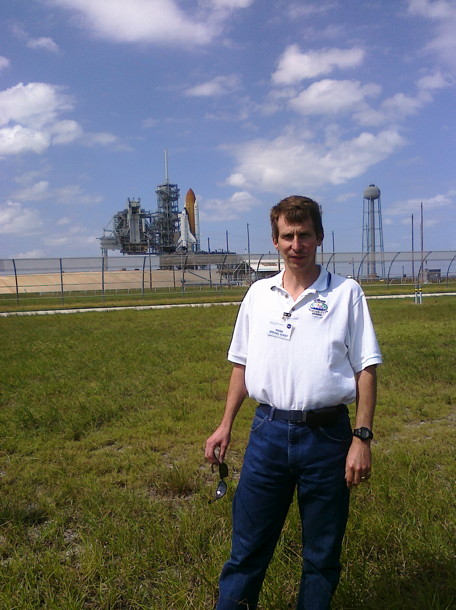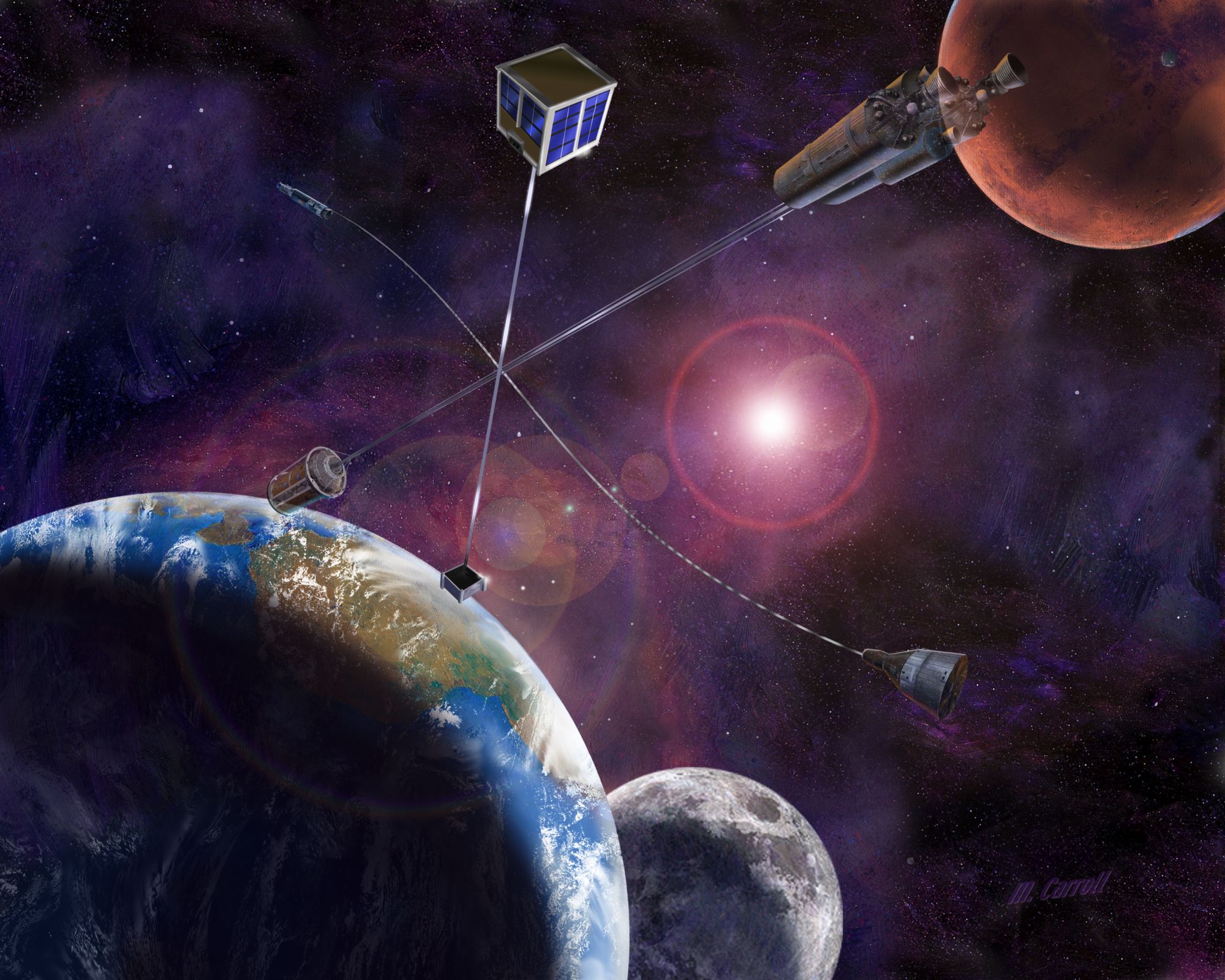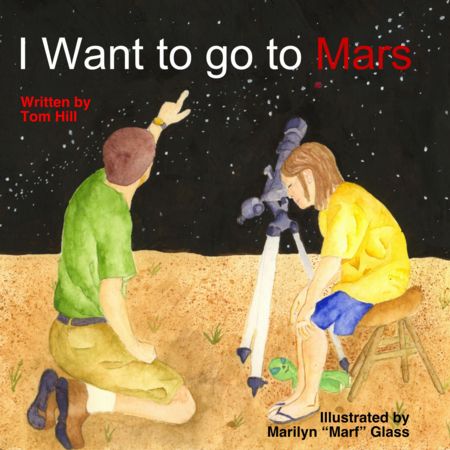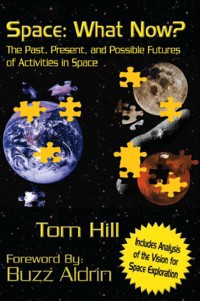|
|
 |
|
Here's the latest on space, and my opinions on it... This is the legacy site, with blog
entries from November, 2004 through June, 2011. Updates after June 9, 2011 can be found at http://spacewhatnow.com/SWN
|
 |
|
|
Thursday, September 29, 2005
A Non-Astronaut?
***Begin short rant***
I try not to spend too much time getting hung up on terms used in news reporting, but one I saw today caught my eye. In this piece, the AP refers to Greg Olsen, they paying customer who'll fly into space this weekend, as the third "non-astronaut" to visit
the station. Call me silly, but anyone who travels above 50 miles is an astronaut. Granted, it seems as though you have
to fly the craft (like the X-Prize pilots did last year) to get an astronaut pin, unless you're on the NASA payroll, when
you can just sit back and enjoy the ride to orbit as one of the five or more people who don't sit at the controls of the shuttle
each time it flies.
***End short rant***
8:34 pm est
Tuesday, September 27, 2005
Mars: The Near-Term Plan
This article led me to this document (500k pdf), titled "Mars Exploration Strategy 2009-2020." It was an attempt, with Spirit and Opportunity en
route to Mars, to map out a plan for the next missions based on the results that the two rovers (along with MGS, Odyssey, and MRO). I haven't read the whole thing, but it looks pretty well thought out.
Of course, the real problem is that we have to focus on one of the options spelled out in the report. For example, one scenario
had us searching for ancient hydrothermal habitats. That's a very cool thing to do, but it would be much cooler to have a
standard Mars lander design by now, build twelve of them, and send three at a time to Mars at each launch window. With development
of the craft finished, money and time could be spent improving the designs of the instruments, getting deeper and deeper into
the mysteries that The Red Planet holds.
7:25 pm est
Monday, September 26, 2005
New The Space Review Essay up
I think that the Wednesday press event for Magnificent Desolation could have been an excellent PR opportunity, and give suggestions as to how and why it's important here. I admit that it probably sounds like whining: Admittedly, some of this essay is based on a personal disappointment.
I’ve never attended a Hollywood premiere, but I was willing to bring my wife, five-year-old son, and one-year-old daughter
into town just for the opportunity to point at someone and say, “He walked on the Moon!” and to hear my son say “Wow!”
Friday, September 23, 2005
Hangin', but not on "Display"
2:33 pm est
No Backup?
NASA's closed down the Johnson Space Center in Houston, transferring control of the International Space Station to Russia. In the "eggs-in-one
basket" category, why isn't there a backup facility for controlling manned spaceflight? A more interesting question relates
to what would have happened if a shuttle were flying right now, since Russia's not equipped to handle that duty. Yet another
priority post hurricane season '05...
Monday, September 19, 2005
Apollo 2 - The Good, the Bad, and the Ugly
I've taken a quick look at the materials released today from NASA. The main web page is here, with graphics spread throughout. There's a FAQ page here, and two Space.com articles here and here. Most of this commentary is based on those sources and their admittedly sparse information and graphics.
- The Good These items are "good calls" in my mind.
- Methane Engines - Developing them now is better than
having to develop them later
- Detachable Heatshield - Disposing of this mass should allow the CEV to serve as a useful
capsule for on-orbit use. For instance, the capsule could be used as the living quarters of the ascent stage of the lunar
lander. Making the shield a replaceable item makes it something that can be produced in greater quantity and likely have
a better production run
- Ability to Land Anywhere on the Moon - We'll see how this stands up to increasing requirements
and decreasing launch capability, but it it stands, it's an excellent capability.
- The Bad These items are minor issues that may self-correct over time
- Space Shuttle Main Engines on the
Heavy Launcher - While I'm sure that some convincing pitches have been made that the SSME can be re-made as a disposable engine,
another engine exists that could do the job, the RS-68. By the way, I don't buy too much into the "man rated" argument.
- Landing
Zones - By specifying landing zones in the Western US and stating that ocean landings are a "backup", the architecture is
constrained as to when it can return to Earth. Another option would be to orbit Earth first when returning from the moon,
but that introduces its own problems.
- Engines on the Landing Vehicle - This may be an artifact of contracted artwork
rather than fully-thought-out plans, but the lander has anywhere from 2 to 4 engines in the images. Big throttling troubles.
- The Ugly These items are fundamental flaws that will either kill the program or perpetuate the status quo of a
few civil servants flying into space each year
- Natural Break Points - According to this plan, we're going to develop
the CEV first, with the CLV ("The Stick") in parallel. Once they're developed, someone can claim victory in having a safer
route to orbit than the shuttle, and shut down the entire Heavy-Lift Launch vehicle development program.
- Two Launches
per Mission to the Moon - in the 1960s, we did it with one launch. Two launches, both of which must go nearly perfectly,
creates another opportunity for a mission failure
- Disjointed Mars Plans/Very Little Applicable Mission Mass - According
to this Space.com article, mass in low Earth orbit for a Mars mission is 500T. That's a lot of fuel (~300T) and a big spacecraft(~200T).
You can go to Mars with that much mass, but you can also use an aircraft carrier to tow water skiiers. As far as applicable
mass goes, the heavy lift booster is good, the tans-lunar stage will likely help, the methane engines (see "the good" above)
are moving in the right direction, but other Mars craft (see this Wikipedia entry) will have to be developed, nearly from scratch. If this Mars hardware was the basis for the moon designs, two heavy launches
would be required for each mission, but habitable space would be added on the moon with each crewed flight.
Friday, September 16, 2005
Interplanetary OPEC?
Once we start some interplanetary commerce, we'll need a source of water (and it's components, rocket fuel and oxygen). Mars is one possibility, but another, a little further out, is Ceres. Recently-released research indicates that Ceres may have LOTS of water. Luckily, there's a mission, named Dawn, that will help verify the theory.
Why you can't Rely on Solar Activity
The sun normally follows an 11-year cycle from Solar Max through Solar Min and back to Solar Max. 2006 is supposed to be
a Solar Min, where the surface of the sun is quietest. , meaning that 2005 should be "almost" a minimum. Well, the sun's
been pretty active. This argues against a sometimes-discussed idea of planning long trips to Mars during solar minimum. If a ship is designed
for traveling during solar minimum (theoretically, such a craft could be built lighter, with less shielding, but I wouldn't
want to fly on it. The smartest way to shield from solar storms is to use food, water and waste products as shields, so the
increase in mass is negligible.), its passengers would get a nasty surprise that they weren't ready for if this week's solar
flares hit while they traveled.
Wednesday, September 14, 2005
"You are Here"
3:53 am est
Tuesday, September 13, 2005
Bad Science on Bad Science Reporting
Here's a good article about how even good sceience research can go bad by the time it's reported through the media. In this case,
the same applies to space reporting.
7:22 pm est
Friday, September 9, 2005
Astronomy on Mars
Space.com has an article about Spirit, one of the rovers on Mars playing astronomer. The article is pretty good, but it doesn't show the night pictures that one of the "little rovers that could" took. At
least some of them can be found here.
11:02 am est
Pale, Blue, Rotating Dot
Take a moment from your stress-filled day to take a look at this movie. It was taken by the Messenger spacecraft as it flew by Earth. Your troubles will seem quite small.
Announcement to Launch Ratio: Infinite
SpaceX has formally announced their new rocket, the Falcon 9. The full press release is accessible from the main page, while the second link shows a large diagram of the booster. I
note the drop of the Roman numerals, as I guess IX would look silly, and naming it the Falcon X would throw off the engines/number
ratio. The big news in this one is that the heavy version has a greater throw mass than the heaviest EELVs, and they're claiming
a reusable 2nd stage. I look forward to see how they're going to do that. Maybe they're doing two and a half stages to orbit,
as I discussed in SWN.
I wish these guys every success in the world, but I'm curious about announcing a third booster project when the first hasn't
flown yet.
10:46 am est
Monday, September 5, 2005
So That's What Formed Saturn's Rings!
Big news from Cassini. Looks like they found the source of at least one of Saturn's rings, making it likely that the others were formed in a similar way. Unfortunately for Sir Arthur, the confirmed method of ring formation doesn't have anything to do with alien intervention in human development millions
of years ago, but everything to do with ice crystals being ejected from a moon...oh well, we'll have to forgive him that one.
Also, be sure to note that the Cassini scientists take a moment to say (paraphrased) "we wouldn't have been able to
do it if we didn't have such a complicated spacecraft." I assume that's a plug for the return to huge spacecraft (like Cassini)
as opposed to the smaller ones we're flying mostly today.
Sunday, September 4, 2005
Still Nothing for Reactors
I'm not up on all the details, but this article discusses plans to get the US producing Plutonium for Radioisotope Thermoelectric Generators (RTGs). We haven't for a long time, and this program will get us back to a rate of 5kg/year. (Cue spooky music). I'm sure that
some folks will focus on on the "1/2 for national security purposes", but the stuff is non-weapons grade. Of course, for
serious exploration of the moon and Mars, we'll need tens-of-kilowatt class reactors. I'm sure that'll raise some hackles
Friday, September 2, 2005
Hardware OK, but the People?
Understanding that there are much more pressing needs from Katrina, NASA released images of the Michoud tank facility. There's been no major hardware damage. The bigger issue for future shuttle flights is likely
to be the workforce. I've heard through a friend-of-a-friend network that 90% of the people who work at Michoud have lost
their homes.
|
|
|
 |
|
|
|
 |
|
Space: Search Now! with Google
| Tom and Discovery |

|
| Taken During a Tour of KSC on 6 Oct 2010 |
| TEMPOł Update |

|
| Click on the picture to go to the Mars Society TEMPOł Page |
| Solar System Ambassadors |

|
| Click on the image above to see Tom's SSA profile |
Email Comments to tom [at]
spacewhatnow.com
| Latest book! Click on the cover to purchase |

|
| I Want to go to Mars is a picture book for beginning readers |
More information on I Want to go to Mars can be found in the devoted section of this web site.
Join the Space:What Now? email list for updates on book events or articles published by the author. Email
addresses will not be shared.
I kind of wrote this off, thinking I was being spammed, but I'd like to know if people are really signing up. Please enter
the text you see below in the second line, and I'll get a warm, fuzzy feeling that people are actually reading and signing
up for mail!

| Now Available! |

|
| Clicking here will take you to purchasing options for SWN |
| Get your SWN Gear! |
|
|
| Powered by CafePress |
|
 |
|
|
|
|
|
Scotty
The Updated Past, Present and Possible Futures of Space Activity
|
|
|
 |

